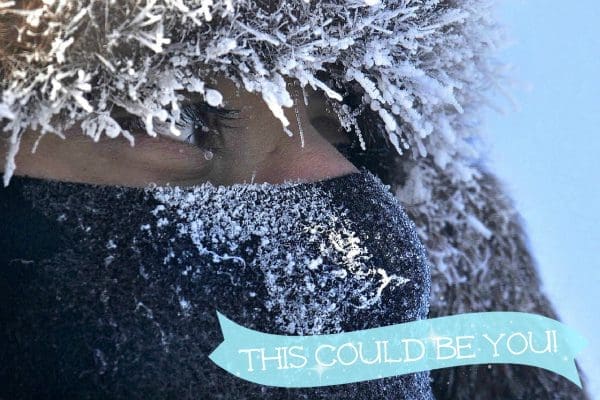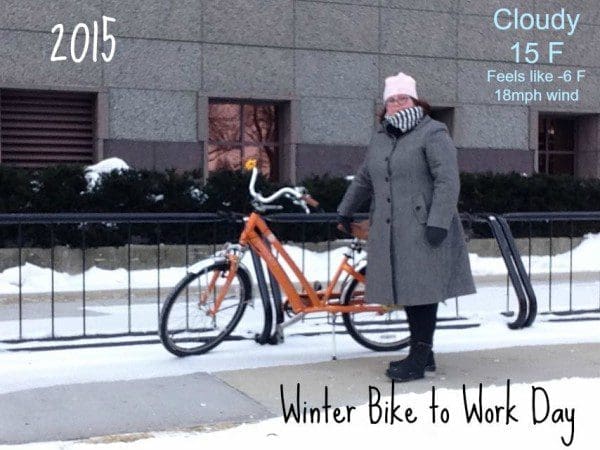
Minnesota is a winter wonderland. Rochester sees an average of 48 snowfall inches a winter. I grew up just outside of Chicago and was no stranger to brutal midwest winters when I moved to Minnesota 20 years ago for college. Even though I’ve grown up with snow and ice as an unavoidable reality, I despise winter. For all of my adult life this meant that I would stay indoors and would try my hardest to have no reason to venture outside. My kids are Minnesota-born and there is no outlook for ever leaving our adopted hometown of Rochester, so I am trying to step up my winter game and embrace the cold.
Snowy and icy streets are a regular sight throughout the months of November to April, and driving conditions can get fairly dicey. Why then are people still hopping on their bikes when the possibility of slipping and sliding threatens to break bones and bruise backsides? Because riding a bike while a soft snow is falling all around you is a magical experience. I discovered this a few winters ago while trying to continue my bicycle commute streak beyond the fall. I now enjoy biking in winter with my children. The months we typically shut ourselves away in our warm homes, schools, cars and workplaces make it difficult to get exercise, especially with activities that take place outside in the fresh air. Some people ski and snowboard, ride snowmobiles and trek down trails in snowshoes, but all of those activities require special seasonable equipment, which can be outrageously expensive. Provided you haven’t hung your bicycle out of reach for the winter season, you already have all you need to enjoy a winter ride!
Here are some tips to get you on your way to your first (or next!) winter ride:
- You will need to bundle up. The winter wear many of us already have for running between cold places is perfectly suitable for winter biking. Yes, you could purchase pricey warm athletic clothes made of wicking fabric, but I find that my long wool coat, a warm knitted scarf, wool or fleece mittens and waterproof boots or shoes work just fine! I dress my children with a slightly heavier under layer since they don’t get as hot as I do when we bike, but otherwise our outerwear is just about the same. If you have a younger child who is just along for the ride and won’t be generating their own heat by pedaling, they may need an extra layer, or sometimes I just drape my daughter with a nice wool blanket and that does the trick!
- Fat bikes are all the rage and they’re great for riding in the snow, but as long as you’re not cruising on skinny racing tires, the standard bike tires work well in moderate ice and snow. You can also let just a little bit of air out of the tires, which helps give them slightly more traction on winter surfaces. If you don’t have fenders installed on your bike, you can add them for a small amount of money, and they’ll be invaluable to both winter and rainy bike riding.
- Don’t expect to get anywhere quickly. When riding in the winter, I give myself extra travel time because not only do I tend to ride a little slower in colder temperatures, but navigating winter roads can take time. I also have found that I needed to vary my route a bit thanks to less-than-ideal plowing on the roads. Thankfully Rochester’s Parks and Recreation Department is purchasing new snow removal equipment this fall and is going to be plowing a larger number of bicycle trails than they have in years past. I don’t mind riding on the roads, but I find that driver’s are even less careful toward bicyclists than normal on winter roads. When I am riding with the kids during the winter, I try to stick to the protected trails as much as we can.
- Prepare for dry skin and lips by putting on and bringing along sunscreen – yes, sunscreen is important in the winter, too! – and chapstick. I also will pack pairs of dry socks for each of us just in case our boots aren’t as waterproof as they should be on a ride. Extra dry mittens or gloves are a good idea, too, especially if it is snowing.
- Helmets should not be optional. In order to keep your head warm you can wear a beanie hat under it or a headband-style ear cover works, too. I have seen winter helmet covers for skiers that could very well fit over a bicycle helmet or you could also use a waterproof helmet cover, which are widely available at a reasonable price. Of course if the temperatures are going to be diving below 0 and you’re still biking (kudos to you!), you can try a balaclava, which will cover your entire face minus your eyes.
- Speaking of eyes, it is a good idea to wear some kind of eye protection for multiple reasons. When ice and snow melt and refreeze over and over, pieces get sharp and become little weapons that your tire can shoot up into your direction. If we are riding when the sun is up, sunglasses are a must and they double for eye protection. If you know it will be getting dark during a ride, I would recommend getting a pair of goggles.
- Because of the lack of sunlight, the other thing you’ll probably need for winter bicycle travel is a light. Sunlight can be unpredictable in the winter months, so in order to see well at all hours of the day, be sure to mount a bright light on the front of your bicycle.
I encourage you to give family winter cycling a try. Embrace the tundra. Bike safely!







